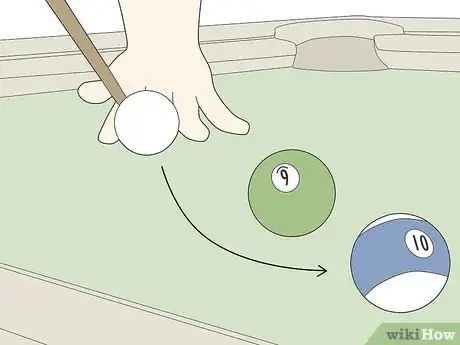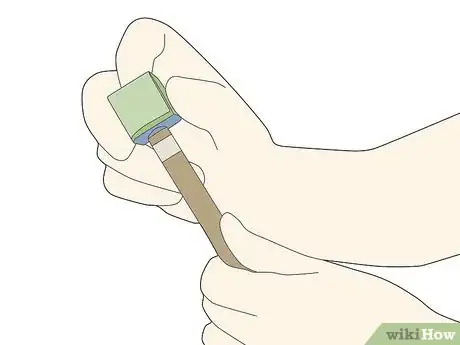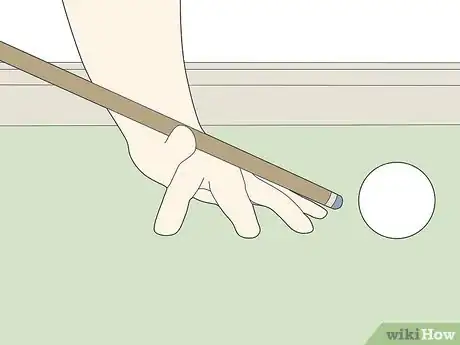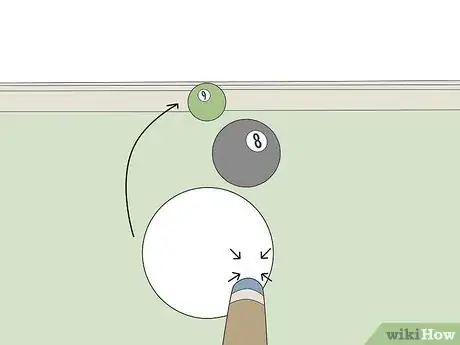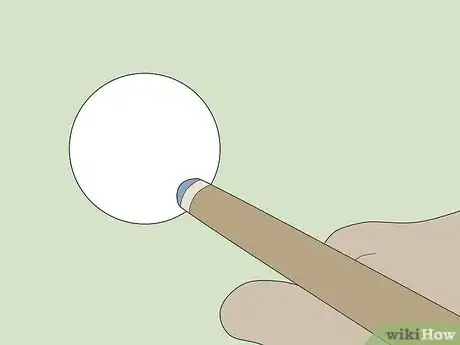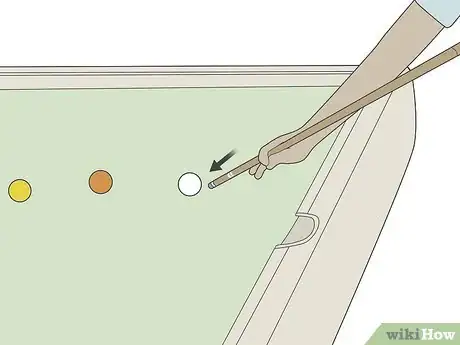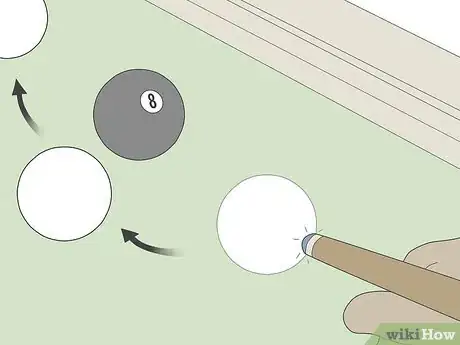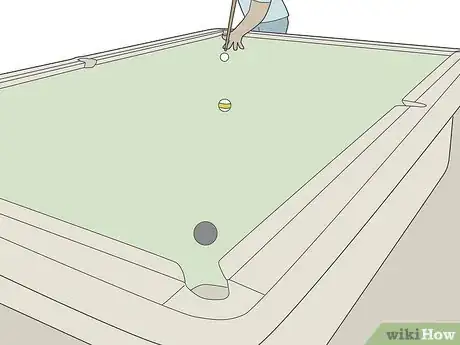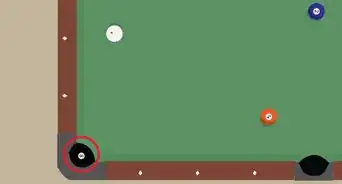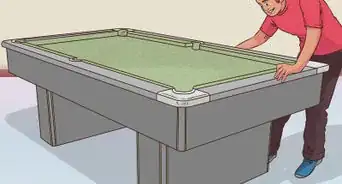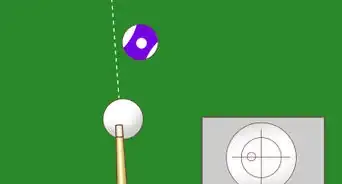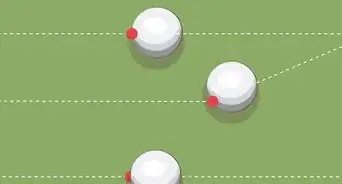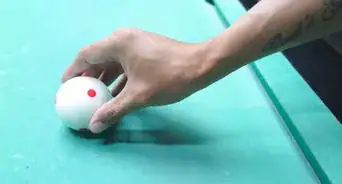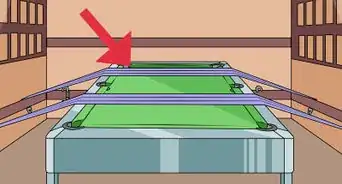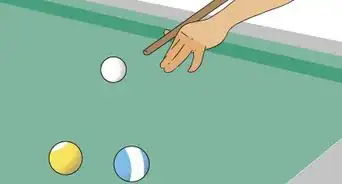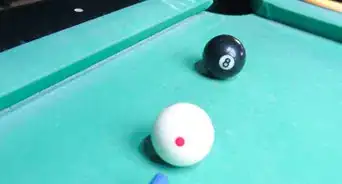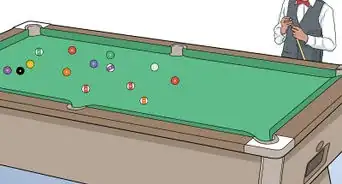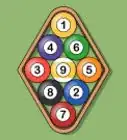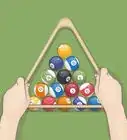This article was co-authored by wikiHow Staff. Our trained team of editors and researchers validate articles for accuracy and comprehensiveness. wikiHow's Content Management Team carefully monitors the work from our editorial staff to ensure that each article is backed by trusted research and meets our high quality standards.
There are 8 references cited in this article, which can be found at the bottom of the page.
This article has been viewed 39,483 times.
Learn more...
A curved pool ball shot, also called a massé shot, is useful for curving the cue ball around a ball that's in the way. To curve your ball effectively, elevate the cue stick and strike the ball below its center. If you want the ball to curve to the left, hit it on its left side, while hitting a ball on its right side will curve it to the right. By spending time practicing, you'll be showing off your curve shot in no time.
Steps
Setting up the Shot
-
1Use the curved shot to curve the ball around another ball that’s in the way. If you’re trying to hit a ball into a pocket and another ball is blocking its direct path, this is the perfect time to curve your cue ball. When your cue ball has a little curve in it, it’ll go around the ball that’s in the way and hopefully hit the correct one.[1]
-
2Apply chalk to the cue stick to create necessary friction. Gently rub chalk on your cue stick, making sure the tip has a fine layer. The chalk will make sure your cue stick doesn’t slip off the side of the cue ball before you’ve had a chance to make your shot.[2]
- If your piece of chalk has a deep groove in it from previous cue sticks, check after you’ve applied the chalk to make sure the chalk actually reached the tip and not just the edges of the stick.
Advertisement -
3Elevate the cue stick to at least a 30-degree angle. Because this shot uses a downward strike, you’ll need to hold the cue stick at much more of an angle than usual. Try holding the cue stick at a 30-, 35-, or 40-degree angle to curve the ball most effectively.[3]
- The exact angle that’s needed will depend on the placement of the balls from each other and around the table, so play around with the angles until you find a method that works for you.
- If your cue stick isn’t elevated, you won’t be able to hit the bottom portion of the cue ball as efficiently.
-
4Rest the tip of the cue stick between your fingers for a steady aim. When you’re holding the cue stick getting ready to strike the ball, give yourself more control of your shot by positioning the tip of the cue in between your thumb and pointer finger, creating a ‘V’. Your fingers should be touching the pool table to give you more stability.
- Hold the cue stick with a loose grip instead of a tight one to give you more accuracy and power in your shot.
- There are several other ways to position the tip of the cue stick between your fingers to take aim, so find one that suits your style.
Striking the Ball
-
1Hit the cue ball on the side you’d like it to curve. If you want your cue ball to curve around a ball and to the right, hit the cue ball’s right side. To make the cue ball curve to the left, hit its left side. Whichever side of the cue ball that you strike is the direction it will curve.[4]
-
2Control the curve by hitting on or below the cue ball’s central axis. The central axis is an imaginary line running around the center of the ball. If you hit the ball above this line, your ball is more likely to go in a straight line instead of a curve.[5]
- Test out different curves by changing how far up or down on the ball you hit it, staying below the central axis.
-
3Strike downward to ensure you hit the bottom of the ball. Since you're holding the cue stick at an elevated angle, it'll be easier to make a downward movement. Avoid trying to level out the cue stick as you’re aiming. Instead, bring it down onto the ball in a straight line.[6]
-
4Use enough force so the cue ball curves around the ball in the way. While you shouldn’t strike the ball so hard that it damages the table or makes the ball pop up, you will need to use more force than you would for a regular shot. Practice putting a little bit more impact into your shots for the best results.[7]
- If you don’t use enough force, the ball may curve around the ball that’s in the way, but it might not have enough speed to hit the ball you’re aiming for.
-
5Spend time practicing to get better at the shot. Curving a pool ball might not come naturally the first couple times you do it. Keep practicing, remembering to elevate your cue stick and hitting the left or right side of the ball depending on which direction you want it to curve. By spending time working on the shot, you’ll learn how to do it well.[8]
- Set up practice scenarios by putting one ball near a pocket, the cue ball set farther back, and the ball that’s in the way placed in the middle of the other two balls.
References
- ↑ https://www.youtube.com/watch?v=YQC56ZneouU#t=30s
- ↑ https://www.billiardsdigest.com/all_about_pool/cue_maintenance.php
- ↑ https://www.youtube.com/watch?v=YQC56ZneouU#t=1m19s
- ↑ https://www.youtube.com/watch?v=WwufMGtxALQ#t=34s
- ↑ https://www.youtube.com/watch?v=-7lsP-XGsD0#t=3m44s
- ↑ https://www.youtube.com/watch?v=4jfoSoh1JA4#t=45s
- ↑ https://www.youtube.com/watch?v=YQC56ZneouU#t=1m27s
- ↑ https://www.youtube.com/watch?v=-7lsP-XGsD0#t=4m58s
